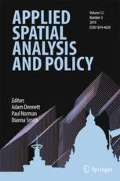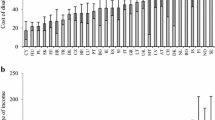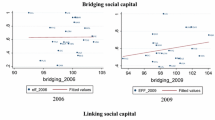Abstract
The aim of this work is to implement a convergence analysis of social expenditure on disability and other social measures (e.g. families and children, disabled people, substances, old age, immigrants and nomadic people, poverty adult problems and homelessness, multineeds, total), taking into account spatial effects. To this purpose, we develop a two-step analysis focusing on Italian regional data for the period 2003–2008. In the first phase, we perform a descriptive analysis and a joint application of a measure of inequality and of the degree of spatial autocorrelation. We subsequently apply the beta and sigma convergence analysis to per capita expenses on social issues, with special emphasis on expenses on disability, broadly defined. The results show that Italian regions do tend to converge in total, and also specific items of per capita social expenditures. In addition, we observe that the discrepancy among per capita expenditures for social actions and services have not been reduced over time, and that spatial effects differ according to the various types of social expenses. Policy considerations are discussed.





Similar content being viewed by others
Notes
The work is based on the definition of social exclusion provided by the EU in the document European Strategy 2020, and is based on three categories, i.e. household work intensity, income, and selected consumption items.
SPISS: Spesa per Interventi e Servizi Sociali.
http://dati.istat.it/Index.aspx?DataSetCode=DCIS_SPESESERSOC&Lang= (Accessed 12 October 2013).
It is possible to compute the number of disabled persons using the services included in the item “disability area”; but not the number of Alzheimer and of psychiatric patients included respectively in the “Old age” and “Poverty adult difficulties and homelessness” areas.
Our analysis of the percentage of disabled people using the services with reference to the total of disabled people shows great variety across regions. We do not investigate whether this is due to lack of service supply, strongly competing private sector, lack of information, and/or cultural traditions.
Expenditures are considered the outlays which refer to each year, whether actually paid that year or not. The method to calculate expenditures is based on the assumption that there is no market price for the commodities produced by the public administration, which are valued as the sum of the various cost components needed for the production of the same goods and services. Expenditures include staff wages, the hiring of buildings and equipment to provide goods and services, and the actual costs of acquiring the goods or services to be provided. If the provision of goods or services is contracted out (for instance to a social cooperative), the recorded expenditure corresponds to the contracting out costs. All expenditures are calculated net of possible contributions from the National Health Service. Values are expressed in constant prices, by applying the deflating index used to deflate the costs of public administration or of not for profit organizations.
In Italy expenditures for old age have consistently been very high, in comparison with other European countries, mainly due to the traditionally generous pension system, which has been little by little altered over the last 15 years. This explains why the proportion of SPISS devoted to old age over GNP has been decreasing over the period considered, despite the increasing number of elderly people.
This study is a part of a larger piece of investigation, where we analyze similar problems, but with respect to all kinds of social expenditures at regional level.
We consider the logarithm of each SPISS item (Rey and Montouri 1999).
We have also developed the analysis on the basis of a different partitioning: North (Piemonte, Valle d’Aosta, Lombardia, Liguria, Trentino Alto Adige, Veneto, Friuli Venezia Giulia, Emilia Romagna), Center (Toscana, Umbria, Marche, Lazio) and South (Abruzzo, Molise, Campania, Puglia, Basilicata, Calabria, Sicilia, Sardegna), obtaining results very similar to the ones found with the partitioning used in the text. Interested readers are welcome to request these results from the authors.
The I Moran Index is similar to the correlation coefficient: it varies between zero and one, −1 and +1. When I equals zero, there is no spatial auto correlation; when I is close to −1 or to +1 there is high spatial correlation, respectively negative or positive.
The I index has the following main characteristics when compared to the coefficient of correlation:
-
a.
it takes one, and not two, variable into account;
-
b.
it incorporates the weights (w ij ) which index the relative areas;
-
c.
it is appropriate to think of it as:”the correlation between neighbouring values on a variable” (O’Sullivan and Unwin 2003).
-
a.
We have computed the significance of the Moran index, which here we occasionally comment on, but which we do not report for brevity. Interested readers are welcome to request these results from the authors.
It is important to note that in this study we only deal with absolute convergence.
The region-specific variable, time-invariant and activated by regional dummy, captures how each region deviates from the average structural relationship common to all regions (the regional fixed effects).
The time-specific variable, activated by time dummies, is useful to clear the structural relationship, which is common to all regions, from cyclical variations that are also common to all regions.
Instrumental Variables could also be used to solve this problem (Anselin 1988).
The complete analysis, here not reported for brevity, is available from the authors.
References
Alsasua, J., Bilbao-Ubillos, J., & Olaskoaga, J. (2007). The EU integration process and the convergence of social protection benefits at national level. International Journal of Social Welfare, 16(4), 297–306.
Alonso, J., Gallindo, A., & Sosvilla-Rivero, S. (1998). Convergence in social protection benefits across EU countries. Applied Economics Letters, 5, 153–155.
Anselin, L. (1988). Spatial econometrics: Methods and models. Dordrecht: Kluwer.
Anselin, L., & Rey, S. J. (1991). Properties of tests for spatial dependence in linear regression models. Geographical Analysis, 23, 112–131.
Arbia, G. (2004). Alternative approaches to regional convergence exploting both spatial and temporal information. Estudios de Economìa Aplicada, 22(2), 429–448.
Arbia G. (2005) Spatial Econometrics. Statistical foundations and applications to regional convergence. Advances in Spatial Science, Springer-Verlag.
Arbia, G., & Basile, R. (2005). Spatial dependence and non-linearities in regional growth behavior in Italy. Statistica, 65(2), 145–167.
Arbia, G., & Costantini, M. (2006). Testing the stochastic convergence of Italian regions using panel data. Applied Economics Letters, 13(12), 775–783.
Arbia, G., & Paelinck, J. H. P. (2003). Spatial econometric modeling of regional convergence in continuous time. International Regional Science Review, 26, 342–362.
Arbia, G., & Piras, G. (2007). Convergence in per-capita GDP across EU-NUTS2 regions using panel data models extended to spatial autocorrelation effects. Statistica, 2, 157–172.
Arbia G., Basile R., Salvatore M. (2002) Regional convergence in Italy 1951–1999: a spatial econometric perspective. ISAE Working Paper n. 29.
Arbia G., Basile R., Piras G. (2005) Using spatial panel data in modelling regional growth and convergence. ISAE Working Paper n.51.
Arlotti, M. (2012). Tagli al welfare: andamenti e caratteristiche della spesa sociale regionale. Italian Journal of Social Policy, 3, 301–319.
Attia, N., & Berenger, V. (2007). Social protection convergence in the European Union: impact of Maastricht treaty. PANOECONOMICUS, 4, 469–487.
Barro, R. J., & Sala-I-Martin, X. (1992). Convergence. Journal of Political Economy, 100, 223–251.
Boeri, T. (2002) Social Policy: One for All? Bocconi University and Fondazione Rodolfo Debenedetti.
Brueckner, J. K. (2003). Strategic interaction among governments: an overview of empirical studies. International Regional Science Review, 26(2), 175–188.
Cornelisse, P. A., & Goodswaard, K. P. (2002). On the convergence of social protection systems in the European Union. International Social Security Review, 55, 3–17.
Corrado, L., Londono, D. A., Mennini, F. S., & Trovato, G. (2003). The welfare states in a United Europe. European Political Economy Review, 1(1), 40–55.
Elhorst, J. P., & Fréret, S. (2009). Evidence of political yardstick competition in France using a two-regime spatial Durbin model with fixed effects. Journal of Regional Science, 20(10), 1–21.
Friedman, M. (1992). Do old fallacies ever die? Journal of Economic Literature, 4, 2129–2132.
Getis, A. (1990). Screening for spatial dependence in regression analysis. Papers in Regional Science, 69, 69–81.
Getis, A. (1995). Spatial filtering in a regression framework. In L. Anselin & R. J. G. M. Florax (Eds.), New directions in spatial econometrics. Berlin: Springer.
ISTAT (2013) Spesa per interventi e servizi sociali. Indagine sugli interventi e i servizi sociali dei comuni singoli e associati. http://dati.istat.it/Index.aspx?DataSetCode=DCIS_SPESESERSOC&Lang=. Accessed 12 October 2013.
Manski, C. F. (1993). Identification of endogenous social effects: the reflection problem. The Review of Economic Studies, 60(1), 531–542.
Mauro, L., & Podrecca, E. (1994). The case of Italian regions: convergence or dualism? Economic Notes, 23(3), 447–472.
Parodi, G., & Sciulli, D. (2008). Disability in Italian households: income, poverty and labour market participation. Applied Economics, 40(20), 2615–2630.
Parodi, G., & Sciulli, D. (2012a). Disability and low income persistence in Italian households. International Journal of Manpower, 33(1), 9–26.
Parodi, G., & Sciulli, D. (2012b). Disability and social exclusion dynamics in Italian households. Germany: MPRA Paper 42445, University Library of Munich.
Püss, T., Viies, M., & Maldre, R. (2003). Convergence analysis in social protection expenditure in the European Union. In E. Ulo & L. Wilder (Eds.), Essays in Estonian transformation economics (pp. 123–46). Uhiselu: Tallinn, Estonia.
Quah, D. (1993). Empirical cross-section dynamics in economic growth. European Economic Review, 37(2–3), 1353–1375.
Revelli, F. (2005). On spatial public finance empirics. International Tax and Public Finance, 12(4), 475–492.
Rey S.J. (2001) Spatial analysis of regional income inequality. REAL Discussion Paper, October 2001.
Rey, S. J., & Elias, M. (2011). Educational performance and spatial convergence in Peru. Région et Développement, 33, 107–135.
Rey, S. J., & Montouri, B. D. (1999). US regional income convergence: a spatial econometric perspective. Regional Studies, 33(2), 143–156.
Ringe, N. (2004). Budgetary constraint or device for collective fiscal retrenchment? The Maastricht convergence criteria & social spending in the EU member states” Paper presented at the annual meeting of the American political science association. Chicago: Hilton Chicago and the Palmer House Hilton.
Sala-i-Martin, X. (1994). Regional cohesion: evidence and theories of regional growth and convergence. European Economic Review, 6, 1325–1352.
Sala-i-Martin, X. (1996). The classical approach to convergence analysis. The Economic Journal, 106, 1019–1036.
Sanz, I. (2005). Is there any race to the top of productive government expenditures? Evidence from OECD countries (1970–1997). European Political Economy Review, 3(2), 29–52.
Skidmore, M., Toya, H., & Merriman, D. (2004). Convergence in government spending: theory and cross-country evidence. Kyklos, 57, 587–619.
Solipaca A., Di Nicola F., Mancini F., Rosano A. (2010) Il gap di reddito delle persone con disabilità: un’analisi regionale. In: Rapporto Osserva Salute 2010, Osservatorio Nazionale sulla Salute nelle Regioni Italiane :16–20.
Young, A. T., Higgins, M. J., & Levy, D. (2008). Sigma-convergence versus beta-convergence: evidence from U.S. Country-level data. Journal of Money, Credit and Banking, 40(5), 1083–1093.
Author information
Authors and Affiliations
Corresponding author
Rights and permissions
About this article
Cite this article
Agovino, M., Parodi, G. An Analysis of Italian Regional Social Expenditure on Disability and Other Social Measures: A Spatial Econometric Approach. Appl. Spatial Analysis 9, 549–567 (2016). https://doi.org/10.1007/s12061-015-9166-y
Received:
Accepted:
Published:
Issue Date:
DOI: https://doi.org/10.1007/s12061-015-9166-y




